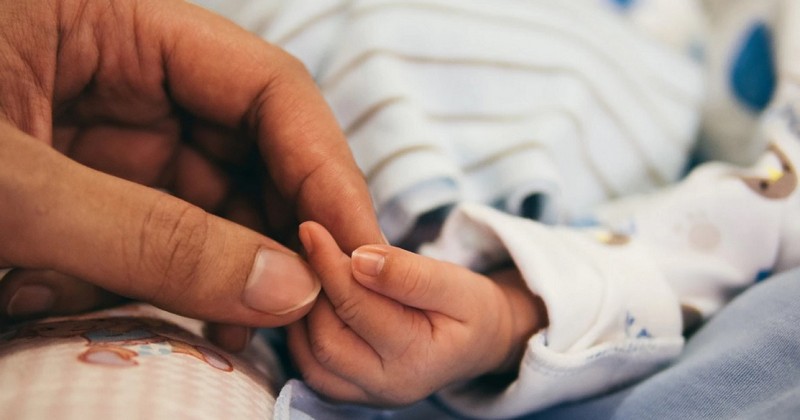Moro reflex: characteristics and clinical implications in infants.

This is one of the primary reflexes manifested in healthy newborn infants.
Reflexes are involuntary responses of the body to stimulation, i.e., unintentional. They indicate a state of normal health. There is a wide variety of primary reflexes, which appear at birth.
In this article we will get to know one of them, the Moro reflexThis reflex is observed at birth and generally disappears after 3 or 4 months. Its persistence or absence usually indicates abnormalities or alterations in development.
Origin of the Moro reflex
The reflex of Moro, also called "of startle of the baby", is a primary reflex that owes its name to the a primary reflex that owes its name to the Austrian pediatrician Ernst Morowho first described it in Western medicine. Its presence in the indicated period indicates normal development in the newborn, and the presence of health.
Ernst Moro (1874 - 1951) was an Austrian physician and pediatrician who studied medicine in Graz, Austria, and obtained his master's degree in medicine in 1899. As we have seen, he not only described the Moro reflex for the first time, but also discovered and named it.
When does it appear?
When a baby is born, it is checked in the hospital for some important primary reflexes, among them, the Moro reflex.
The Moro reflex is fully observed in newborn babies born after one week of age.It is incomplete in babies born after the 34th week of pregnancy, and incomplete in those born prematurely after the 28th week.
This reflex extends up to 3 or 4 months of life. Its absence or persistence may indicate neurological defects or alterations of the nervous system.. During the first 4 months, the pediatrician will continue to check during the visits if the child still has the reflex. Even beyond these months, because, as we will see in detail later, the persistence of the reflex beyond 4 or 5 months may indicate certain neurological defects.
What does it consist of?
To see how the Moro reflex appears, the baby should be placed on his or her back on a soft, padded surface. Gently lift the baby's head with sufficient support and begin to take the weight off the cushion; that is, the baby's body is not lifted off the cushion, only the weight is taken off. Then The baby's head is then suddenly released, dropped backwards momentarily, but then quickly held again.The baby's head is then suddenly released, momentarily dropped backwards, but quickly supported again, not allowing it to hit the cushioned surface.
The baby will then usually respond with a startled look; his or her arms will move to the sides with palms up and thumbs flexed. The baby may even cry for a minute.
In other words, the Moro reflex appears when the baby feels a lack of support. when the baby feels a lack of support (it can also appear when there is a sudden change of position). When the Moro reflex comes to an end, it ends in this way; the baby pulls the arms back towards the body, with the elbows bent, and finally relaxes.
Alterations
The absence or persistence of the Moro reflex indicates certain alterations in normal development:
1. Absence of the reflex
The absence of the Moro reflex in an infant is abnormal, and may suggest, for example, damage to the brain or spinal cord.. On the other hand, if it occurs on only one side, there is a possibility of a fractured clavicle or damage to the brachial plexus nerve bundle.
2. Persistence of the reflex
If the Moro reflex persists beyond the fourth or fifth month of age, it may also indicate severe neurological defects. This is why its existence continues to be checked in pediatricians' offices.
Its phases
But what does the Moro reflex mean in the context of an integrated evaluation of the central nervous system? Let us first take a look at the components involved in the reflex:
- The startle reflex.
- The movement of the arms in abduction.
- The movement of the arms in adduction.
- In general, the cry.
Thus, the absence of these components (with the exception of crying) or an asymmetry in the movements is not normal. The persistence of these components in children and adolescents is also not a good sign..
On the other hand, some people with cerebral palsy may have a persistent and exacerbated Moro reflex. As we have seen, abnormalities in its manifestation indicate brain or spinal cord disorders.
Syndromes with the altered reflex
Some of the syndromes with an abnormal Moro reflex are Erb-Duchenne palsy (upper brachial plexus palsy); this presents with an asymmetrical Moro reflex, caused by shoulder dystocia.
Another syndrome, this time with an absent Moro reflex, is DeMorsier syndrome. DeMorsier syndrome, which includes optic nerve dysplasia.. This syndrome presents with the absence of the reflex as part of specific complications unrelated to the shoulder and its nerves.
Finally, the absence of the Moro reflex is also detected in newborns with Down syndrome. newborns with Down syndrome and in neonates with perinatal listeriosis.. The latter is a rare infection related to the ingestion of contaminated food and can have serious consequences for the mother and the newborn.
Bibliographic references:
- García Madruga, J.A.; Deval, J. (2010). Developmental Psychology I. Cognitive and linguistic development. UNED. Madrid
- MedlinePlus. (2019). Moro reflex. Medical encyclopedia.
- Paris, E. (2014). The Moro or startle reflex in the infant. Babies and more.
(Updated at Apr 14 / 2024)